
Guittern
Carlos Gonzalez, 1991

As early as at the end of the 13th century, a small plucked string instrument with a rounded shape coexisted with the lute : it is the gittern. Endowed with a head shaped as a sickle, it is cut in a solid block of wood, and the four courses of strings (less frequently three or five) are tied at the end of the body, just like the modern mandolin. It is smaller in size than the lute, shows a higher-pitched diapason, and has probably a role in the treble. Like the medieval lute, the gittern is played with a bird’s feather. It was played in all social strata:some narrative documents represented it at the king’s court and in poems gittern sometime rhymed with tavern.
In the 14th century, a new style, name the Ars Nova, appeared in France and soon spread out in Italy. Johannes Ciconia's piece comes from one of the many manuscripts of vocal music of this style.
In the 15th century, some documents mentioned a few virtuosos of the instrument, the most famous of them being Pietrobono, at the court of Ferrare. The German lutenist and organist Konrad Paumann wrote an instrumental version of the song Mit ganczem Willen, which can be found in an even more ornamented form in the organ book from Buxheim (circa 1460-1470). These two versions follow each other in the present recording.

Guittern
Carlos Gonzalez, 1991

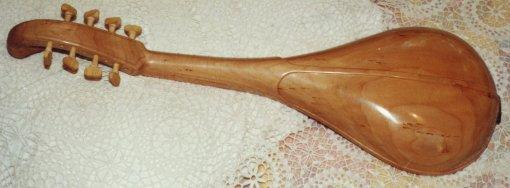

Probably eclipsed by the all new renaissance guitar, the medieval gittern declined at the end of the 15th century. It seems that it was from Spain, more precisely from Navarra, that the gittern came back to France around 1570 under the name of mandore, derived from the Spanish word bandurria. The body was, then, either cut in a solid block of wood, in the ancient way, or "ribbed", like the lutes with its four single strings usually tuned in fourth and fifth. German musicologist Praetorius and Italian lutenist Piccinini's testimonies are confirmed by the inventories drawn up after the death of some Parisian instrument makers: the mandore was widely used in France, certainly as well as the lute. However, very few pieces composed for it did survive, probably a consequence of its mainly popular utilization. The Tablature de mandore by François de Chancy, published in 1629, is the most refined repertory for this instrument. It contains six suites of dances and a series of brawls.

Mandore
Carlos Gonzalez, 1995

The French mandore was well introduced in Italy as soon as 1660. At first, the Italians doubled the four strings of the mandore, and they tuned it an octave higher that the lute, in fourths and thirds. Towards 1700, a fifth bass string was added, then a sixth. This instrument, highly praised during the first half of the 18th century, was called at that time mandola or mandolino. The most famous pieces are of course the concertos by Vivaldi, but this mandolin was also being used in opera arias or in oratorios.
Carlo Arrigoni was a composer and lutenist at the court of Florence, and he composed several sonatas for mandolin and thorough bass. In order to “realize” this thorough bass, we have used a theorbo, which looks like a large bass lute with a double neck, specially invented during the 17th century for this purpose.
Only very recently did we discover that the great harpsichord player Domenico Scarlatti also composed for mandolin. Starting from a manuscript titled Sonatina per mandolino e cimbalo we found at the Bibliothèque de l’Arsenal in Paris, the mandolinist Ugo Orlandi has been able to establish that the instrument, which was never mentioned in the score of several sonatas by Scarlatti, is in fact the mandolin. The sonata in G minor which is recorded on this CD contains typical chords for lombard mandolin that no other instrument can easily play. The harpsichord accompanies it and enhances its sound.

Lombard Mandolin
E. Saunier, ca 1780
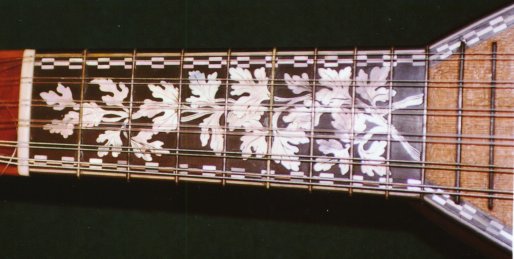
Towards 1750 (or earlier, according to some specialists), a very different and new kind of mandolin appeared. It would quickly become – and is until now known as - the « standard » mandolin. It has four double strings, all made of brass, except for the highest strings made of gut. It is tuned like a violin, and is played with a bird’s feather. This instrument was probably born in Rome, but the stringed instrument makers in Naples, especially the Vinaccia family, took it to such a high level of excellence that its name has remained attached to the town throughout centuries. Towards 1760, Neapolitan composers like Majo, Barbella, Cecere and mandolinists like Giuliano or Gervasio composed sonatas, duets, trios and even concertos for this instrument. Emanuele Barbella was mainly a violinist, and his cheerful personality shows through his numerous compositions for mandolin or violin. Italian mandolinists traveled through Europe to show their virtuosity and to train students. Gabriele Leone is probably one of the best. After he mesmerized the Parisians playing mandolin sonatas at the « Concert Spirituel », he became for one season the manager of the director of the London Opera, then returned to Paris where he published his matchless Méthode raisonnée for mandolin in 1768. Leone is probably the one who took the mandolin technique to its highest level at that time. In the 6th variation of the 3rd movement of the sonata recorded on the CD, he sometimes demands to play two different notes on the two strings of a same course.
French musicians like Pierre (“Pietro”) Denis and Jean Fouquet (“Fouchetti”) learnt to play the mandolin with their Italian colleagues. Competing with Leone, Denis rather fulfilled the wishes of the middle class amateurs, so much so when he adapted some ariettes (songs) for mandolin from opéra-comiquepieces. This genre, which mixes songs and spoken parts, was launched by philosopher and musician Rousseau. It describes middle-class people or peasants expressing their feelings with more simplicity but as nobly as the aristocracy, which foretells the social upheavals of the French Revolution in 1789. Aline, Reine de Golconde, (« Aline, queen of Golconde ») by Monsigny was performed in 1766; Denis published his variations in his Méthode pour apprendre à jouer de la mandoline sans Maître (method to learn how to play mandolin without a teacher ) in 1768.
Valentin Roeser
is a German musician who
worked in Paris. He composed a lot of music for wind instruments and
symphonic orchestra. His ‘Six sonatas for two violins and bass that can
be played with a mandolin’ (1769) are typical trios from the « Mannheim
school », with their short melodic phrases clearly structured, and their piano/
forte contrasts.
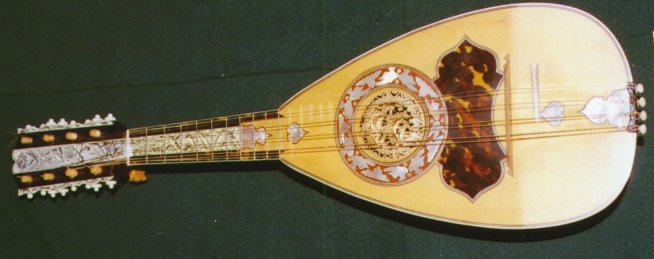
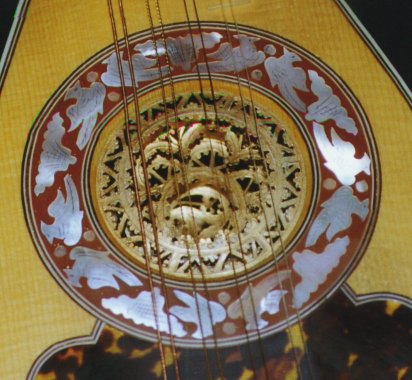
In this record, the bass part of Roeser’s trio is played with a mandolone (also called liuto), which is a double string bass mandolin tuned like a modern guitar, and played with a plectrum. On the other hand, in Leone’s sonata, we decided to play the « bass » on a viola, one octave higher than in the published part: this choice which might surprise was probably the choice of the composer, too. Since the 1760s in France, the usage of a thorough bass gradually disappeared in chamber music, and the bass, which was not figured anymore, was in fact mostly a cello part. But some pieces for mandolin such as some sonatas by Giuliano and some trios by Barbella indicate that the bass can – or must - be played with a viola. The first published sonatas for violin and viola accompaniment by Joseph Haydn (Paris, Bailleux, 1775) were titled ‘Six sonatas for violin alone with the bass’. Is it illogical then, to consider that the accompaniment of the opus 2 sonatas by Leone, published two years later by the same publisher, was meant for the same instrument?

Mandolone
Carlos Gonzalez, 1987
(upper instrument : neapolitan mandolin attributed to Gennaro Vinaccia,
circa 1760)

Whereas the mandolin
gradually disappeared in France after the revolution of 1789 and was
only played in limited groups in Italy at the end of the century, it was
still praised around 1800 in Germany, in Bohemia and in Vienna, where
several scores were being published. Mainly Beethoven and Hummel's names
appear in music dictionaries. Hummel, a famous German pianist composed a
concerto for the Italian mandolinist Bartolomeo Bortolazzi,
native from the region of Brescia. This virtuoso, who mainly appeared in
northern Europe, played a single gut string mandolin tuned like a
violin, he called Brescian or Cremonese. However, this new
kind of mandolin was never able to take over the two classical mandolin
patterns called neapolitan and lombard. Bortolazzi was also one of the
first composers to write compositions [éviter répétition avec “pieces”
de la phrase suivante] for mandolin and guitar. In the piece
published in 1803 and recorded here, you will recognize a theme from the
symphony « Drumroll » by Haydn.

Giovanni Hoffmann, a Viennese composer of whom we know very little, composed around 1800 some nice chamber music pieces in which the mandolin is associated in varying combination with the violin, the viola and the cello, and a concerto for mandolin and chamber orchestra. This serenade is the unique genuine mandolin and alto duet composed during the classical age. This long composition also contains two minuets framing the Romance. Hoffman exclusively composed for a 6 coursemandolin tuned in fourth : it was either the double string lombard mandolin, or the single string Milanese mandolin that appeared towards 1800 and that would still be in use in Northern Italy until the early 20th century.
From 1820, the mandolin
sustained a nearly complete absence as a « cultivated » instrument. It
mainly survived as a popular instrument in Italy, and it was only
towards 1870 that it would flourish again all over Europe. But this is
an other story ...
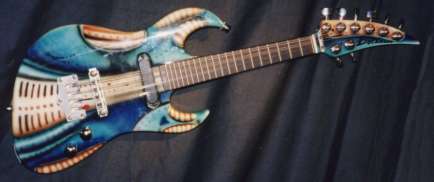
Copyright © 2003 Association Gabriele Leone